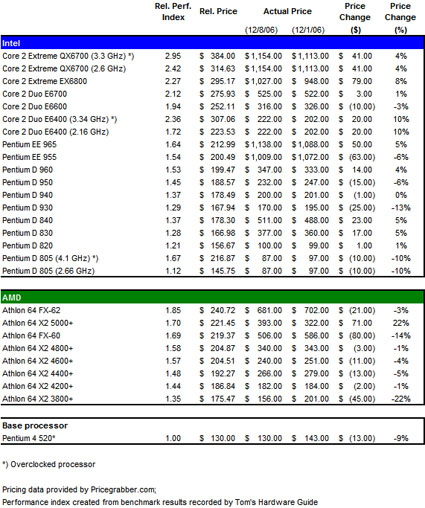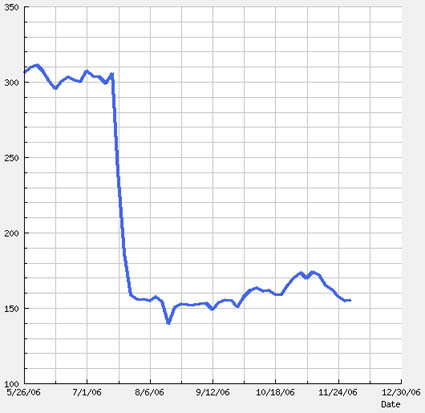Launch of 65 nm CPUs rings in new round of AMD retail price drops
Introduction
Chicago (IL) - Last week, news of the unveiling of AMD's Quad FX platform coincided with prices for virtually all of the company's existing processors decreasing. This week, the company introduced its first 65 nm X2 processors, which caused average retail prices to slip across the board.
The pricing data collected this week confirmed the overall shaky position of AMD's processor lineup. There's a transition on the very high-end, with dual-dual-core processors (sorta Quad FX or formerly 4x4) headed for the retail market and some mainstream processors being replaced by a new 65 nm ("Brisbane") models. It is certainly a bit early to claim that all these new products have shifted AMD's retail prices already, but it is certainly interesting to watch that most retail and e-tail prices of AMD's CPUs are moving south, while comparable Intel processors are getting more expensive as Christmas demand is hitting warehouses.
On a positive note for AMD, the overall downward shift helped to bring down prices on some of the AMD processors that had been creeping up over the past several weeks, and thus the price/performance correlation for AMD reached an all-time high for our weekly feature. Keep a close eye on this development to find the best deal for you.
This week marks our 10th processor/performance article since we re-introduced the feature on October 6. Over that time, we've tracked a lot of trends and logged a lot of data for both Intel and AMD. However, this week struck us as one of the most interesting, especially because of AMD's continued price drops.
AMD set a lot of records for us this week. First off, probably the most significant processor that saw a decrease in average price is the FX-60, which is no longer officially supported by AMD, but has been in high demand, apparently. Despite being in the final phases of its official lifespan, it has had a tendency to rise in price over the past couple months, and in fact, until now, the average price never fell below our initial recorded price on October 6 of $546. This week, it saw the biggest decline in price of all the processors we've been watching, dropping $80 from last week's price of $586 to $506, a 14% decrease, and a new record low for our charts.
The 4600+ and 4200+ also logged the lowest price we've seen in the past ten weeks. The 4600+ fell $11, to show a 4% drop from $251 to $240, and the 4200+ dropped minimally to pass the record low that was tied last week. Additionally, the 3800+, which fell 22% to log a $45 drop from $201 to $156, tied the record low that was set on our first day of October 6, and is also the biggest week-to-week price decrease in our records for the processor. So, if you are out for an AMD processor and you really don't care if your chip is built in 90 nm or 65 nm and if it consumes a bit more power, then there are definitely several good deals out there right now.
E-tail price history of the Athlon 64 X2 3800+. the sharp dropped occured after a massive price reduction as reaction to Intel's new Core 2 Duo processors and aggressive Pentium D 900 pricing. Data provided by pricegrabber.com
Get Tom's Hardware's best news and in-depth reviews, straight to your inbox.
It's also worth noting that, amid the massive price decreases, the 5000+ took a completely opposite turn: Since October, we've recorded prices on the 5000+ in the mid to low $300 range. All of the sudden, this week it shot up $71, climbing 22% from $322 to $393, the highest price we've seen since October 20. This is not only related to some manufacturers actually not offering this chip this week, but also in increased demand: The X2 5000+ has evolved in AMD's main weapon against the Core 2 Duo processors, as it provides performance that is comparable to the midrange of Core 2 Duo CPUs (E6300/E6400). You can actually watch this scenario in retail stores, which offer quite a number of $1000 PCs, especially HP and Gateway models, with this processor. Interestingly enough, though, the 5000+ is the only AMD processor that's been notably underpriced in relation to the others. So this price increase actually helps out AMD's association between price and performance.
expensive

Mark Raby is a freelance writer for Tom's Hardware, covering a wide range of topics, from video game reviews to detailed analyses of computer processors.

